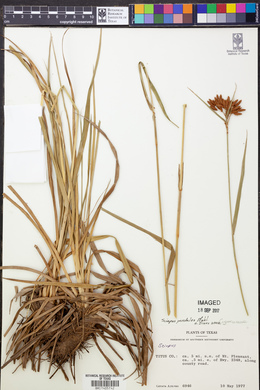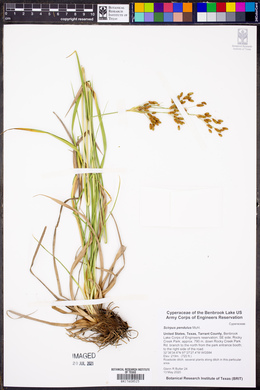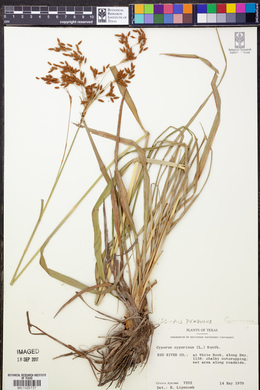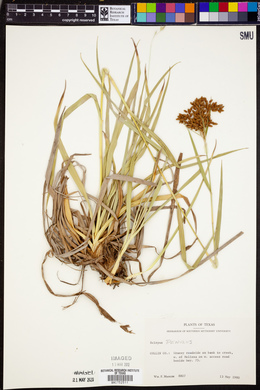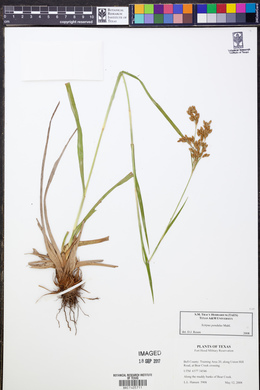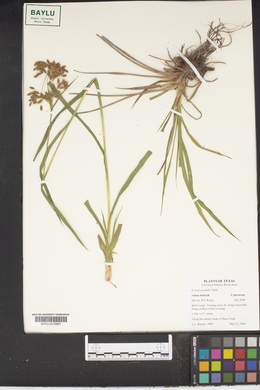Scirpus pendulus
|
|
|
|
Family: Cyperaceae
Rufous Bulrush, more...drooping bulrush, hanging bulrush
[Scirpus lineatus f. elongatus Eames] |
Plants cespitose; rhizomes short, stout. Culms: fertile ones upright or nearly so; nodes without axillary bulblets. Leaves 5-7 per culm; sheaths of proximal leaves whitish; proximal sheaths and blades with septa few, inconspicuous; blades 15-40 cm × 4-8(-12) mm. Inflorescences terminal only or sometimes also with 1(-2) lateral inflorescences from distal leaf axils; rays ascending or weakly divergent, rays and pedicels scabrous near nodes, otherwise smooth, rays without axillary bulblets; bases of involucral bracts green or speckled with red-brown, not glutinous. Spikelets in open cymes, central spikelet of each cyme sessile, others long-pedicellate, spikelets ovoid to lance-ovoid or subcylindric, 5-10(-12) × 2-3 mm; scales brown to red-brown with green midribs, ovate, 2 mm, apex mucronate, mucro 0.1-0.3 mm. Flowers: perianth bristles persistent or brittle and breaking off near base, 6, slender, strongly contorted, much longer than achene and often projecting far beyond it despite being strongly contorted, smooth, enclosed within scales or scarcely projecting beyond them; styles 3-fid. Achenes pale to medium brown, elliptic in outline, plano-convex or plumply trigonous, 1-1.2 × 0.6-0.8 mm. 2n = 40. Fruiting late spring-early summer (Jun-Jul). Marshes, moist meadows, ditches, often associated with calcareous substrates; 0-600 m; N.B., Ont., Que.; Ala., Ariz., Ark., Calif., Colo., Conn., D.C., Fla., Ga., Ill., Ind., Iowa, Kans., Ky., Maine, Md., Mass., Mich., Miss., Mo., Nebr., N.H., N.J., N.Mex., N.Y., N.C., Ohio, Okla., Oreg., Pa., S.Dak., Tenn., Tex., Vt., Va., W.Va., Wis.; Mexico (Coahuila); introduced, Australia. Prior to 1966, the name Scirpus lineatus was incorrectly used for S. pendulus (A. E. Schuyler 1966). A nineteenth century Buckley collection from 'Valley of the Lower Rio Grande,' may reflect an introduced population that has not persisted.
Perennial herb with short, tough rhizomes, tufted to 1.5 m tall Leaves: three-ranked, five to seven per culm. Sheaths of lower leaves whitish. Blades 15 - 40 cm long, 3 - 8 mm wide, keeled beneath. Inflorescence: a single, large, branched arrangement of spikelets, terminal, sometimes also lateral (usually just one, rarely two), subtended by three leaf-like bracts. Bracts basally green or with reddish brown speckles. Flowers: minute, subtended by a floral scale, lacking sepals and petals, bearing six bristles. Bristles slender, very contorted, much longer than achene, more or less enclosed within the scales, persistent or brittle. Stamens one to three, exserted. Pistil one. Style linear, three-cleft, base persistent. Fruit: a one-seeded achene, brown, about 1 mm long and over 0.5 mm wide, elliptic, plumply three-sided or flat on one side and convex on the other, minutely bumpy. Culm: stout, upright, to 1.5 m long, three-sided, solid. Spikelets: in open clusters, central spikelet of each cluster stalkless, others long-stalked, 0.5 - 1 cm long, 2 - 3 mm wide, egg-shaped to egg- lance-shaped. Floral scales spirally arranged, brown to reddish brown with a green midrib, 2 mm long, egg-shaped with a rounded apex that bears a tiny point. Similar species: No information at this time. Flowering: mid-May to late June Habitat and ecology: Common in moist meadows. It is also found in ditches, marshy areas, woodlands, and along streams. Occurence in the Chicago region: native Etymology: Scirpus comes from the Latin name for a bulrush. Pendulus means hanging. Author: The Morton Arboretum Cespitose perennial to 1.5 m from short tough rhizomes; stems rigid, upright, with only a terminal infl or sometimes 1 or rarely 2 lateral infls; blades 3-10 mm wide; infl decompound; bracts usually shorter than the rays; spikelets elongating to 6-13 mm, usually 1 in each terminal cluster sessile and the others pedicellate, often drooping; scales obovate-elliptic, 1.7-2.2 mm, acuminate or conspicuously mucronate, with green midstrip and chestnut sides; bristles 6, brown, contorted, smooth, twice as long as the achene; style trifid; achene pale purple-brown to brown, compressed-trigonous, 1-1.3 mm, sharply short-beaked; 2n=40. Marshes and wet meadows; Me. to Minn., S.D., and Colo., s. to Fla., N.M., and n. Mex. Fr June, July. (S. lineatus, misapplied) Gleason, Henry A. & Cronquist, Arthur J. 1991. Manual of vascular plants of northeastern United States and adjacent Canada. lxxv + 910 pp. ©The New York Botanical Garden. All rights reserved. Used by permission. From Flora of Indiana (1940) by Charles C. Deam This is the most common bulrush of the state. It is frequent throughout and, for the most part, is found in roadside ditches and along low roadsides. It prefers a moist or wet soil along streams, in low, open woodland and fallow fields, and about lakes and sloughs. …… Indiana Coefficient of Conservatism: C = 2 Wetland Indicator Status: OBL |
|
|
|





























